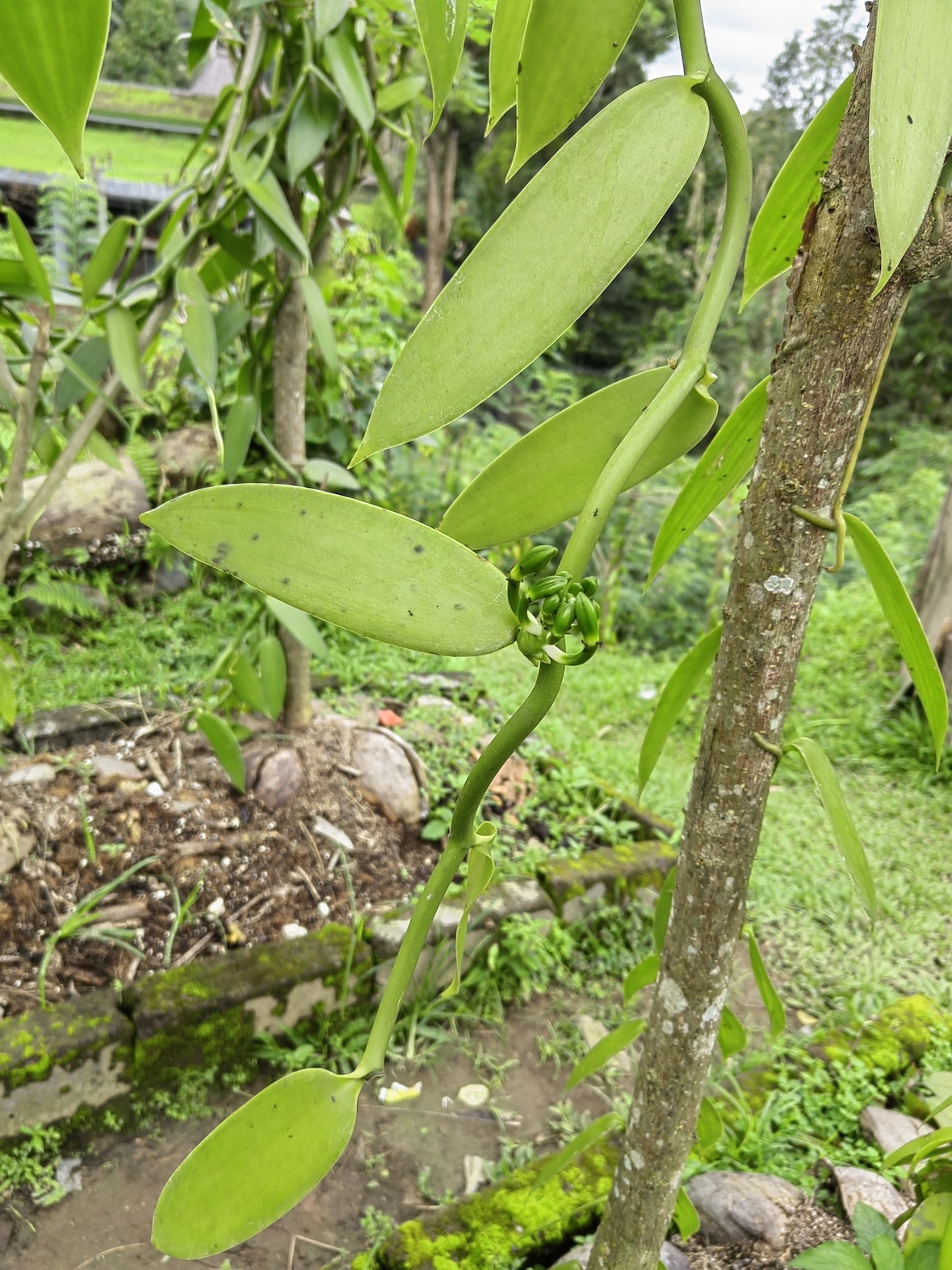
After answering some questions, I thought it would be beneficial to detail how we expect to get a vanilla plant to produce pods.
We select a shade tree and plant a young vanilla taken from a cutting at the base, mulching it with compost as it grows, perhaps every 3 months.
After 1 year it will have reached maybe 2m high and allowed to fall back, creating a loop. As the vine gets to 4m long, it has 2m attached to the tree and is brushing the ground with the tip. We encourage the vine to grow back up the tree, creating a loop with new roots in the ground.
By the end of the 2nd year, we should have 3 to 4 loops, one of which will have formed a new branch, also becoming a loop. At this stage, growth speeds up, and during year 3 we will have perhaps 5 or 6 such loops.
At this stage, we start to prune the down side of the loop, removing perhaps 4 leaves which form new cuttings. We now have a trailing branch and a new plant growing up the tree, which will flower the following year. The trailing branch is likely to produce 2 new branches at the top, and in the next few months, it will produce flower clusters down the trailing branch.
By year 4, we will have perhaps 10 or as many as 20 if we think the rainy season will be mild.
Each trailing branch will produce between 2 and 10 flower clusters, depending upon length, in other words the height of the shade tree, and proper nutrition. Each flower cluster will produce 15-20 flowers, and we aim to pollinate 10 of these and produce beans from them.
After the beans are harvested, with an average weight of 17g, we leave the trailing branch if not all the buds have flowered, and over the next three years they will all flower, after which the branch can be pruned.
In this manner we can keep the vine in constant production and maintain a high yield.
What can go wrong?
In a word, weather. We need to keep wind blowing around the vine. Although it likes 80% humidity, it wants moving humidity. No wind makes it stagnant and causes rot. If we have a particularly heavy rainy season, we will lose all the fruiting trailing branches if they are too close together. In other words, if we are too greedy, as we were in our first year with up to 25 trailing vines, we lose the fruit. All of it.
Now, we are experimenting to see what we can do to keep the yield high in heavy rains. We can keep the vines alive and fruiting, but the yield is a fraction of expected yield.
After 3 ENSO (El Nino Southern Oscillation) rainy seasons in a row, we are expecting a mild rainy season next year which will give a tremendous yield. This one will have a poor yield. We expected this to happen every 6 years (historical data indicates every 9 years) but this is the third triple ENSO since 1950.
Some of the things that farmers are trying, all with degrees of success:
Growing long lengths of vanilla, up to 8m, then removing it, cutting off all the roots and leaving it suspended in the growing area. All the buds flower… and the fruit ripens using the last strength of the vine.
Loop the last two or three loops above the ground, so it cannot root. Then stretching it out, cutting off all the roots. It flowers.
Deliberately damaging the main shoot of the vine. Everything after that will flower, with the flow of nutrients cut off.
What doesn’t work is just leaving it! The vine will happily grow larger and larger, but it needs stress and the cutting off of nutrients to cause it to flower.
In nature, it reaches the top of the tree and starts to flower – with the flow of nutrients so high severely restricted…
What we are having to do is find a happy medium. We targeted 5kg per plant originally, knowing it is possible to get as high as 30kg (you need to run it all over a tall tree and be good at climbing…). But we also used short shade trees and that didn’t work. Too dense growth meant poor air circulation and we lost fruit. We are raising all our shade trees to a minimum of 2m and keeping the lower branches clipped to encourage air circulation. Now, we are experimenting to see how many trailing branches we can manage per tree. We don’t have the answer yet, and no doubt this will change every year with the weather, but we hope to establish some boundaries.
For example, can we guarantee a minimum of 1kg never mind the weather? Could we prepare the tree with 20 trailing branches, then cut them away and flower them separately if the weather turns bad? Intriguing questions, which we are working on!
Rex Sumner
Royal Spice Gardens is an Indonesian Foreign Investment Company, in Indonesia known as a Perusahaan Modal Asing (PMA).
NIB Licence number 0220100502286. NPWP: 94.830.504.0- 905.000.
PT Royal Spice Gardens Indonesia, Jl. Raya Pejeng, Tampaksiring, Gianyar, Bali 80552, Indonesia
Website by Simia Solutions / Cre8 Design Studio
Powered by Pak Kriss’s Compliance Framework.
Even in uncertain times, credible, stable & realistic opportunities are available for the astute investor.
Get the edge by obtaining clear, concise and rapid information. Fill out the form to receive our latest prospectus!